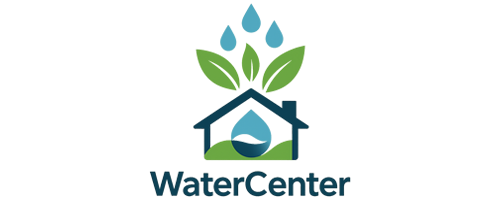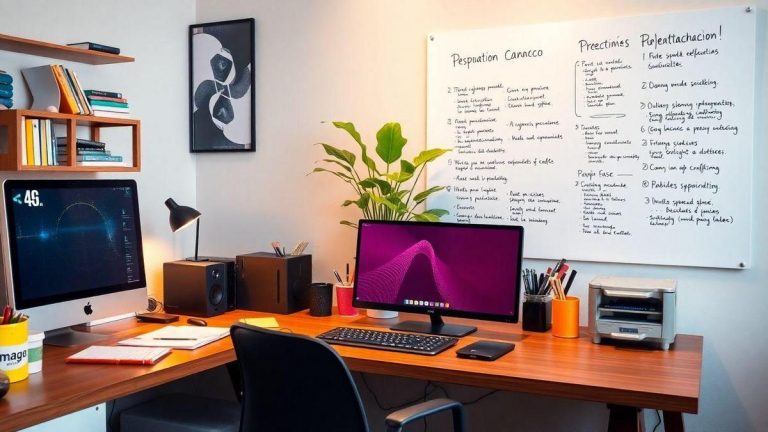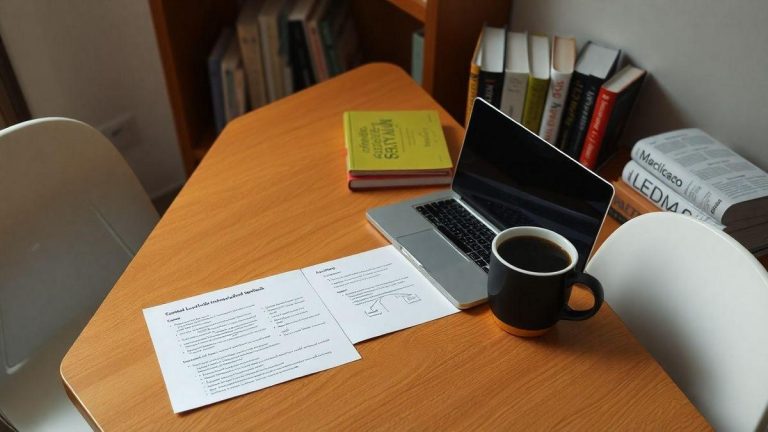How to Read and Understand Technical Documentation Without Going Crazy
How to Read and Understand Technical Documentation Without Going Crazy is an almost impossible mission, but fear not! In this article, I will share my super effective tips to turn this tedious task into something more fun and, who knows, even palatable. I'll talk about how to organize information, where to find a cup of coffee to help with reading, and how to use bookmarks. Get ready, because this journey through technical documentation will be anything but boring!
Tips for Reading Technical Documentation Without Freaking Out
Organizing Technical Information
Reading technical documentation can be like trying to decipher hieroglyphics in a language I don't speak. But after a few tries (and many cups of coffee), I've learned that organize the information is the key! Here are some tips I use:
- Divide and Conquer: Instead of reading everything at once, like a superhero on a mission, I break the documentation down into smaller chunks. This way, I can focus on one topic at a time.
- Use Bookmarks: When I find something important, I use bookmarks or take notes. This helps create a map of what I already understood and what still needs attention.
- Abstracts: I like to make short summaries. It's like turning a thousand-page book into a five-page story. It makes reviewing easier.
Creating a Comfortable Reading Environment
Believe me, the environment where I read technical documentation makes all the difference! Here are some tips that help me avoid freaking out:
- Adequate Lighting: I always look for a well-lit place. Dim light is great for a horror movie, but terrible for reading code!
- Silence or Music: I can't work in complete silence. Sometimes, soft instrumental music helps me concentrate. But be careful! Don't put on your heavy rock playlist unless you want to dance, not read.
- Comfortable Chairs: I learned the hard way that an uncomfortable chair can turn any reading experience into a real ordeal. Invest in a chair that doesn't make you feel like you're sitting on a rock!
The Importance of Hot Coffee
And, of course, I can't forget my faithful squire: coffee! A hot coffee is like a magic that keeps me alert. Here's what I always do:
| Step | Description |
|---|---|
| 1 | I make a generous cup of coffee. |
| 2 | I add a little sugar (or not, it depends on the day). |
| 3 | I drink while I read, to keep my energy up! |
So if you're wondering How to Read and Understand Technical Documentation Without Going Crazy, remember: organize your information, create a comfortable environment and never underestimate the power of a good coffee!
Technical Reading Strategies That Work
Using Bookmarks and Annotations
When I get a technical documentation, the first thing I do is attack with a notepad and colored pens. Seriously, if you're not taking notes, you're missing the party! markers They're like superheroes in my reading journey. They help me highlight the most important parts, like pointing to a treasure map.
Here are some tips I use:
- Emphasis important definitions.
- Take note questions that arise as I read.
- Use colors different categories, like: blue for examples, green for concepts, and red for things I didn't understand (which are many, believe me).
Summarizing What I Read
After reading and taking notes, it's time to summarizeAnd no, I'm not talking about making a summary that makes me sleepy, but rather creating something that makes sense and that I can understand later.
How to Write Summaries That Don't Make You Sleepy
Here are some tips I've learned along the way:
| Tips | Description |
|---|---|
| Be brief | Use short, direct sentences. |
| Use your words | Don't copy and paste. Rewrite in your own words. |
| Include examples | This helps to fix the information. |
| Review | Always take a look at what you have written. |
With these strategies, I can read and understand technical documentation without going crazy! Have you tried any of these tactics? If not, it's time to give them a try!
Interpreting Technical Texts: My Way
Deciphering Complicated Jargon
Ah, the technical jargon! They're like that friend who only talks about things no one understands. A true torture for anyone trying to read technical documentation! What do I do? I simply ask myself: What is this text trying to tell me?
For example, if I see the phrase "software architecture is scalable," I imagine it means something like the program can grow without breaking. This way, I transform the complicated into something that makes sense in my head. It's like performing magic, but without the rabbit and the top hat!
Practical Examples to Facilitate Understanding
Let's get to work! Here are some examples of jargon and their translations into English. simple Portuguese:
| Technical Jargon | Simple Translation |
|---|---|
| Continuous Integration | Installing new versions of the program is easy |
| API (Programming Interface) | Like a waiter bringing orders |
| Sorting Algorithm | A recipe for organizing things |
These examples show that with a little creativity, we can make technical reading much easier and more fun.
Turning Jargon into Plain Language
Now for the fun part! Turning jargon into something I can understand is like turning water into wine. Here are some tips I use:
- Break the text: Read it in parts. Don't try to swallow it all at once, as if it were a giant sandwich.
- Use analogies: Compare concepts to everyday things. For example, think of software as a factory. Each part has its function!
- Ask: If something doesn't make sense, ask someone. Don't be afraid! Everyone has gotten lost in a technical text.
With these tips, I managed to unveil many mysteries and not go crazy in the process!
Simplified Technical Documentation: What Is It?
When I started programming, one of the first things I came across was the technical documentationAh, the documentation! That collection of texts that feels more like a maze than a guide. It's like trying to understand what an alien is saying after eating some very spicy beans. But, calm down! Let's unpack this together.
What to Do When Documentation Is a Maze
If you've ever felt lost amidst technical terms and jargon that seem like a foreign language, you're not alone! I've been there. Here are some tips that helped me avoid losing my mind:
- Read the Summary: Most documentation has a summary at the beginning. It's like a movie trailer—it gives you a sense of what to expect.
- Look for Examples: Practical examples can often be more helpful than theoretical explanations. They're like maps that show the right path.
- Don't Be Afraid to Ask: If the documentation doesn't make sense, ask! Online communities are great for this. Remember: there are no silly questions, only silly answers!
Online Resources That Help
The internet is full of resources that can be your best friend when it comes to understanding technical documentation. Here are some that I use:
| Appeal | Description |
|---|---|
| Stack Overflow | A forum where you can ask questions and find answers from other programmers. |
| GitHub | Often, project documentation is there. And, look, it's easier than it seems! |
| YouTube | There are videos explaining everything from the basics to the advanced. And who doesn't love a good video tutorial? |
Tools That Make Reading Easier
There are a few tools that can transform reading documentation from a nightmare into a smoother experience. Here are a few I love:
- Previewer: For those who are not familiar with , this tool helps to visualize how the text will look, making it easier to read.
- Online Dictionaries: Sometimes the documentation uses words that seem to have come straight out of a history book. A dictionary can help decipher these mysteries.
- Browser Extensions: Some extensions help highlight important parts of the text. It's like having a superpower when studying!
Reducing Stress in Technical Reading
Relaxation Techniques Before Reading
Ah, technical reading! It's like trying to understand an alien speaking a language I've never heard. To keep my brain from collapsing, I always use a few relaxation techniques before diving into the documents. Here are some of them:
- Deep Breathing: Before opening the book, I take a deep breath and exhale as if I'm trying to push a cloud away. This helps calm my nerves.
- Relaxing Music: I put on a playlist of calming music. I don't know if it helps with reading, but at least I feel like I'm in a spa while I read.
- Stretch the BodyA good stretch is like saying "hi" to my body. I stand up, stretch my arms, and say, "Come on, body! Let's read this complicated text!"
Setting Reading Goals
Now, let's talk about reading goalsI'm not a superhero, so I can't read it all at once. So I break it down into smaller chunks. Here's how I do it:
| Goal | Description |
|---|---|
| Chapter 1 | Read an introduction and understand the basics. |
| Chapter 2 | Focus on practical examples. |
| Chapter 3 | Take notes and summaries. |
With these goals, I feel like a mini-winner with every step. And who doesn't like to feel victorious, right?
How to Celebrate Small Achievements in Reading
After reading each part, I have a little celebration. It could be something simple, like:
- A piece of chocolate: Because chocolate is the answer to almost everything in life.
- An episode of my favorite series: It gives me something to look forward to while I read.
- Tell someone about what I learned: Not only does this make me feel smart, but it also helps me remember what I've read. Besides, who doesn't like being the "know-it-all" in the group?
Documentation Reading Guides: My Top 3
Books That Helped Me
Ah, books! Those paper friends who always have something to teach. I'll share my favorites that helped me understand the technical documentation without going crazy. Here they are:
| Title | Author | Why is it good? |
|---|---|---|
| Clean Code | Robert C. Martin | Teaches you how to write clean, readable code. |
| You Don't Know JS | Kyle Simpson | Simplifies JavaScript in a fun way. |
| The Pragmatic Programmer | Andrew Hunt & David Thomas | It brings practical tips and funny stories. |
These books are like that friend who always has a solution, even if you're feeling lost in a code maze.
Websites and Blogs that Simplify Everything
Now, let's talk about the internet. Yes, that place where you can find dancing cat and also programming tips! Here are some websites and blogs that helped me not freak out:
- Stack Overflow: The programmer's Bible. If you have a question, this is the place to go.
- MDN Web Docs: The world's most user-friendly site for learning about the web.
- Dev.to: A community where you can read experiences from other developers.
These sites are like maps in an unfamiliar city. They showed me the way, and believe me, without them, I'd still be lost in the confusing code.
My Personal Guide to Technical Documentation
If you are thinking: “But how do I do that? read and understand technical documentation without going crazy?”, here’s my personal guide:
- Read carefully: Don't try to devour it all at once. It's like eating a cake; you don't want to choke!
- Take notes: Writing down the important parts is like putting post-its in a book. It helps you remember!
- Practice: The best way to learn is by doing. Try applying what you read to small projects.
- Ask for help: If you're confused, ask! Don't be afraid to be the "newbie" in the conversation.
These tips are like a cake recipe: if you follow them, the result will be delicious (or at least, it won't burn!).







